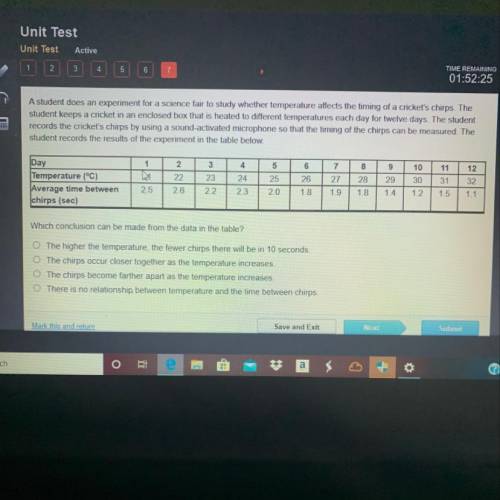
Mathematics, 16.04.2020 13:23 carriecarl3530
A student does an experiment for a science fair to study whether temperature affects the timing of a cricket's chirps. The
student keeps a cricket in an enclosed box that is heated to different temperatures each day for twelve days. The student
records the cricket's chirps by using a sound-activated microphone so that the timing of the chirps can be measured. The
student records the results of the experiment in the table below
1
2
22
2.6
Day
Temperature (°C)
Average time between
chirps (sec)
3
| 23
2.2
|
4
24
2.3
6
26
5
| 25
2.0
7
27
1.9
8
28
1.8
9
29
1.4
10
30
1.2
11
31
1.5
12
32
1.1
2.5
1.8
Which conclusion can be made from the data in the table?
O The higher the temperature, the fewer chirps there will be in 10 seconds
O The chirps occur closer together as the temperature increases.
O The chirps become farther apart as the temperature increases
There is no relationship between temperature and the time between chirps.


Answers: 2
Another question on Mathematics

Mathematics, 21.06.2019 15:30
If x + 10 = 70, what is x? a. 40 b. 50 c. 60 d. 70 e. 80
Answers: 2

Mathematics, 21.06.2019 21:30
The table shows the number of students who signed up for different after school activities. activity students cooking 9 chess 4 photography 8 robotics 11 select the true statements about the information in the table.
Answers: 2

Mathematics, 22.06.2019 00:00
Awindow has the shape of a rectangle with a semi circle at the top. find the approximate area of the window using the dimensions shown. 4ft by 8ft
Answers: 1

Mathematics, 22.06.2019 00:00
Aspacecraft can attain a stable orbit 300 kilometers above earth if it reaches a velocity of 7.7 kilometers per second. the formula for a rocket's maximum velocity v in kilometers per second is vequalsminus0.0098tplusc ln upper r, where t is the firing time in seconds, c is the velocity of the exhaust in kilometers per second, and r is the ratio of the mass of the rocket filled with fuel to the mass of the rocket without fuel. find the velocity of a spacecraft whose booster rocket has a mass ratio of 20, an exhaust velocity of 2.1 km/s, and a firing time of 15 s. can the spacecraft achieve a stable orbit 300 km above earth?
Answers: 3
You know the right answer?
A student does an experiment for a science fair to study whether temperature affects the timing of a...
Questions

Physics, 19.10.2021 14:00

History, 19.10.2021 14:00





Mathematics, 19.10.2021 14:00

Physics, 19.10.2021 14:00


Social Studies, 19.10.2021 14:00


Advanced Placement (AP), 19.10.2021 14:00

Social Studies, 19.10.2021 14:00









